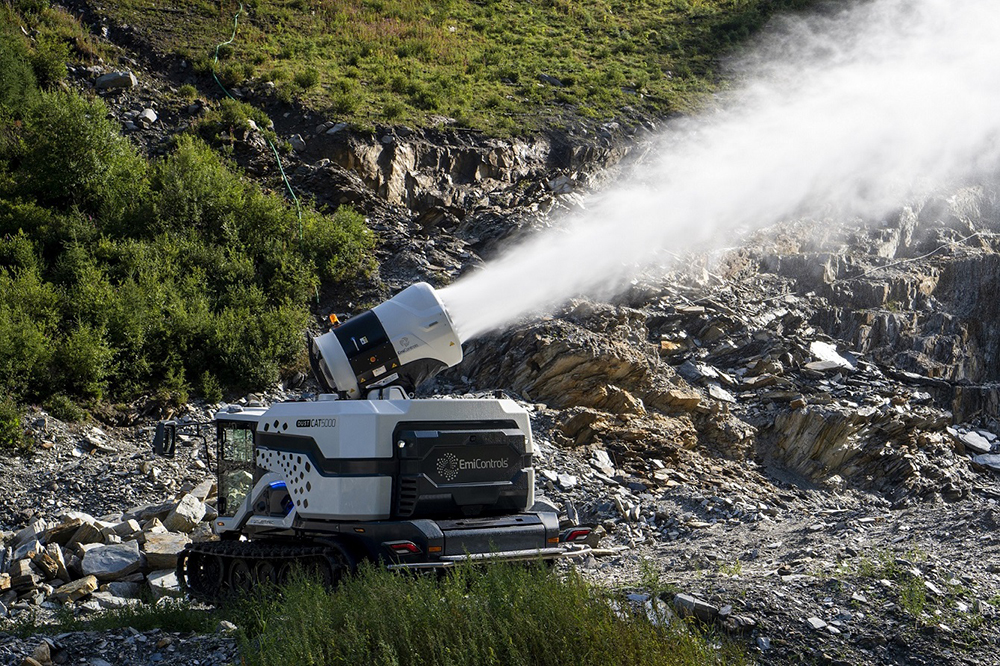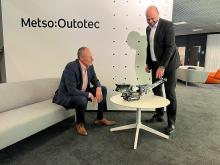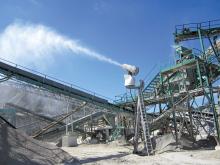EmiControls, a leading innovator in the field of dust abatement, offering tailor-made, water-mist-based solutions for protection against dust, odour and fire, has recently launched a groundbreaking first all-electric dust-suppression vehicle, the DustCat5000.
Created in partnership with fellow Bolzano, northeast Italy-based companies E-Powertrac and Lanatec, the revolutionary machine is said by EmiControls to be designed to prevent and abate dust in difficult and inaccessible terrains, such as mines and quarries, minimising the impact of dust on the surrounding environment.
The idea was born at the request of one of Europe's largest mining and quarrying groups, which wanted to sustainably minimise one of its Swedish mine’s dust impact. In November 2022, the first vehicle was shipped and operated for test purposes.
The turbine-equipped vehicle is fully autonomous and flexible thanks to its six to eight hours of battery-powered operating time and a 5,000-litre water tank. Its crawler chassis allows it to navigate any ground condition and reach areas inaccessible by traditional vehicles.
The turbine is said by EmiControls to boast impressive operational capabilities, including the ability to function at temperatures as low as -25C, and a water-mist-throwing distance of up to 90 metres, allowing it to cover a large area while minimising water consumption and costs. This is said to make it an incredibly sustainable solution for dust abatement, something EmiControls has always been committed to.

EmiControls says it is excited to bring this cutting-edge technology to its industry markets and looks forward to helping businesses in the mining and quarrying sectors improve their environmental impact. The DustCat5000’s ability to operate in challenging environments and reduce water usage will, says the company, be an industry game-changer.
Commenting on the prototype’s work at the Swedish customer’s mine, Alverman Soster, EmiControls Dust Division manager, says: “The mine extracts many different minerals. The problem is that an underground mine has this slag waste material generated by the extraction process. The mining group has to put that material somewhere, but it is extremely fine and dry, so dust clouds can blow over many kilometres when the wind blows.
“The group had been looking for a solution for many years. They were using a helicopter to fly over the site and spray water – but you can imagine the cost of this approach. They were looking to buy rather than rent the helicopter, but then you also have the fuel cost, and a pilot is not a standard operator with a regular salary.
“I visited the Swedish mine in 2018, and we began thinking about a possible solution. Another company within our group started looking for an electric-vehicle solution offering a low carbon footprint that could run everywhere on site. We then put our dust-abatement system with this vehicle. The mining group did not use the DustCat5000 much in January, February and up to the middle of March, as there was some snow around. But in the last five to six weeks, they have been using it more and more every day, as it is getting hot and dry. The DustCat5000 has already done more than 450 working hours.”
Soster says the same large mining and quarrying group is considering investing in another DustCat5000 machine to work at the same Swedish mine and further models to work at some of its other mine sites. “It is a very big group with other mines in Sweden, Norway and Finland,” he emphasises. “The group has one massive quarry in the north of Sweden and is looking at potentially investing in four DustCat5000s. The area they have to manage is like a huge lake.
“In the current test environment, dust can fly up to 30 kilometres! The main problem is the impact on neighbouring villages, which can occasionally be covered by white quarry dust. The slag in the fine dust contains metals, which creates a problem for agriculture, water ponds and local health. However, the DustCat5000 has been working well for the customer alongside our V22 Orca, which can also produce snow for dust abatement. Snow can be good for catching flying dust and is an effective alternative to spraying only water on a surface, especially in winter when water can easily turn to ice, creating another health and safety issue for site workers.”
Soster says he also has a copper mine in Poland whose operator is considering placing an order for four Dust Cat5000s. “They have the same issue as the Swedish mining customer in needing an effective dust-suppression solution that can cover a big area.”
Soster says DustCat5000 operators at the Swedish customer’s mine site have praised the vehicle’s cabin. “They say it is huge, very comfortable and offers a really good view. They also like the vehicle’s heating system. In many other machines in colder weather, they have to work wearing heavy jackets, hats and gloves. In the DustCat5000, they quickly remove these items. The prototype also has a very good radio and music system that you can connect up to your smartphone.”
Commenting on the DustCat5000’s six- to eight-hour per electric-charge operating time, Soster says: “The operating time per charge depends on how much you drive the vehicle. The big advantage of its turbine is that you can park the machine in a certain position and leave it to do the [dust-suppression] job. Also, if you work in an area with wind, you greatly increase the spraying distance of the turbine. It can travel up to 150 metres. It takes a few hours to recharge the DustCat5000. Using our supercharger, you can reach 80% charge in a couple of hours.”
Soster says that EmiControls is creating more production capacity at its headquarters. Any customer placing an order for a DustCat5000 will have a lead time of around seven months. “We eventually plan to offer the DustCat5000 as a fully remotely controllable autonomous vehicle, but at the moment, we are focused on taking it from being a prototype into full production.
“We see the DustCat5000 as initially being a vehicle for European customers. We also have seen interest from markets like North America, South America and Australia. However, there are different regulations and potentially high maintenance and servicing costs in making the vehicle more widely available. We will see how the product develops.

“We have a good partner in Australia, and business for all our solutions has grown there in the last year and a half. From what I’ve read, the Australian government is pushing more and more mining companies to use good dust-suppression solutions to protect their employees. Many employees suffer from silica and other dust-related illnesses after 20 years of work.”
Soster says EmiControls is also growing its US business. “We have two partners, one in Salt Lake City, Utah, taking care of customers in Utah and nearby states. The other partner is in Albany, New York state. It’s a small but very active company we teamed up with a few months ago. Many New York state officials are going around construction and other industrial work sites measuring dust levels and asking for fees if deemed too high. That is creating business opportunities for us. We are also looking for another partnership in Texas, a rich state with many commercial opportunities.”
Commenting on EmiControls’ European market footprint, Soster adds: “Scandinavia is investing a lot of money in our market areas, especially Sweden and Finland. Germany and Italy are always big markets for us. We have opened a subsidiary, EmiControls Europe, in Frankfurt. We are also seeing business in Spain and Portugal.”
While set to benefit commercially from the world’s increasing focus on greater sustainability and environmental protection, including via dust suppression, Soster emphasises that EmiControls’ dust-suppression solutions always look to deliver optimal performance while limiting water use. “We need to spray water when it’s needed to spray water. You can do that with a high level of automation. An automated solution means that when you don’t have so many people on-site when working, for instance, on weekends, the work still generates dust that needs to be suppressed.
“Our new software management system allows many EmiControls’ machines to be automated, managed and operated remotely. We are working on it now and setting it up for remote use to control and monitor the system from anywhere in real time.”
Talking about the growth of EmiControls, Soster says: “I joined the company in 2015, and there were just seven people, now there are 30 people. Our annual turnover in less than eight years has increased tenfold. We have invested a lot of money in development and research and are going forward. Of course, we are keen to sell the machines we manufacture, but we also want to sell more complete solutions. That means more aftermarket support on spare and replacement parts and product maintenance.”








